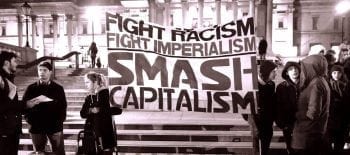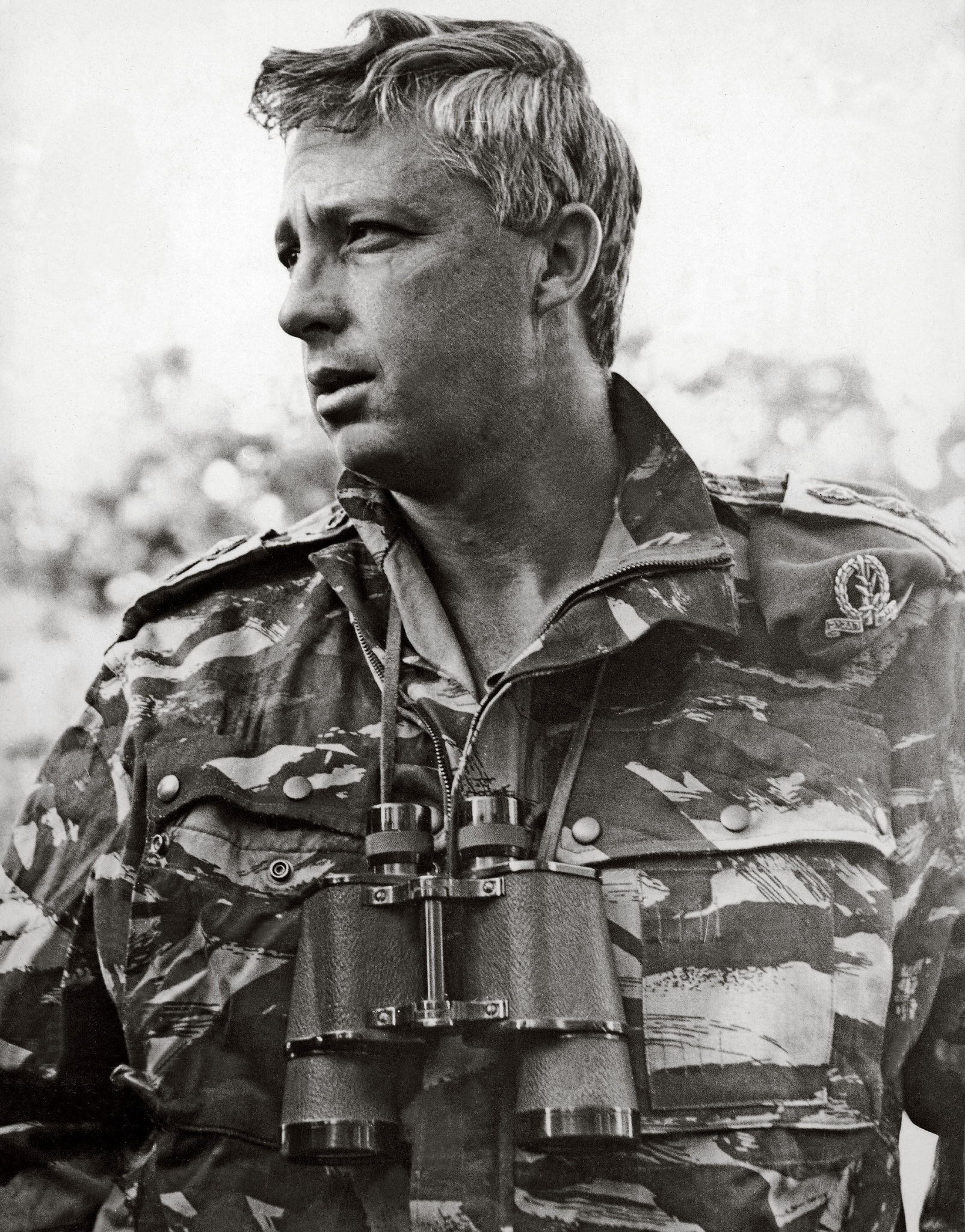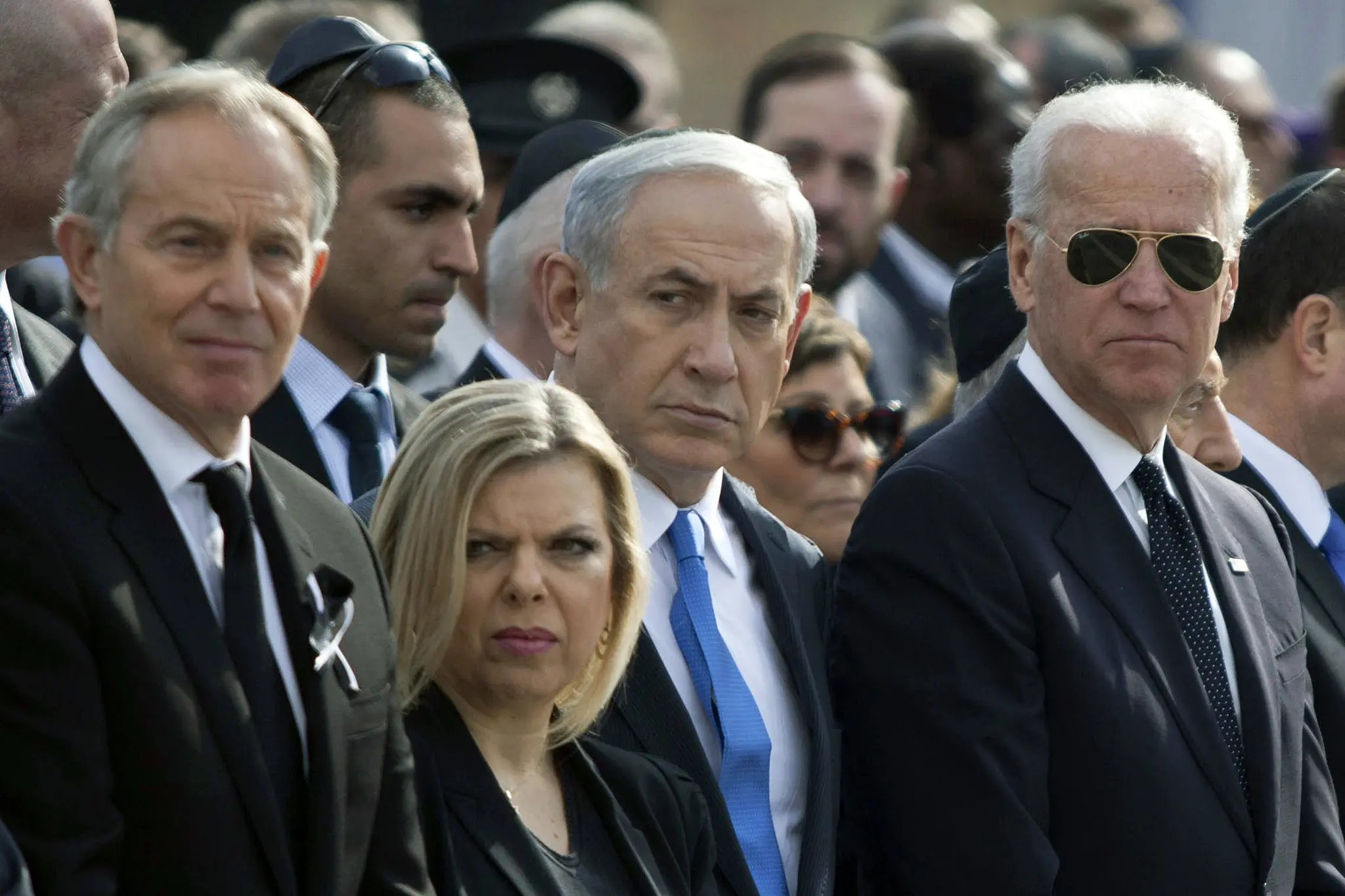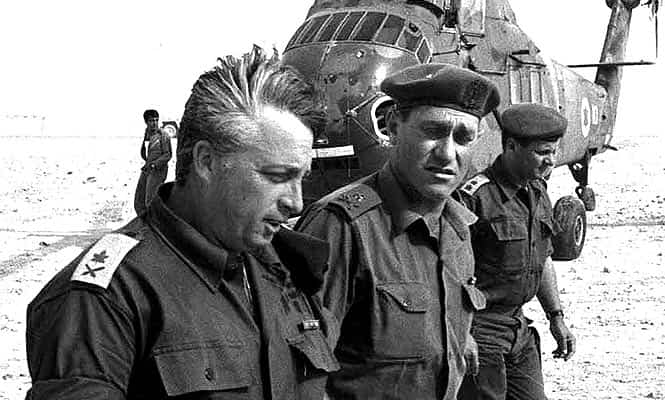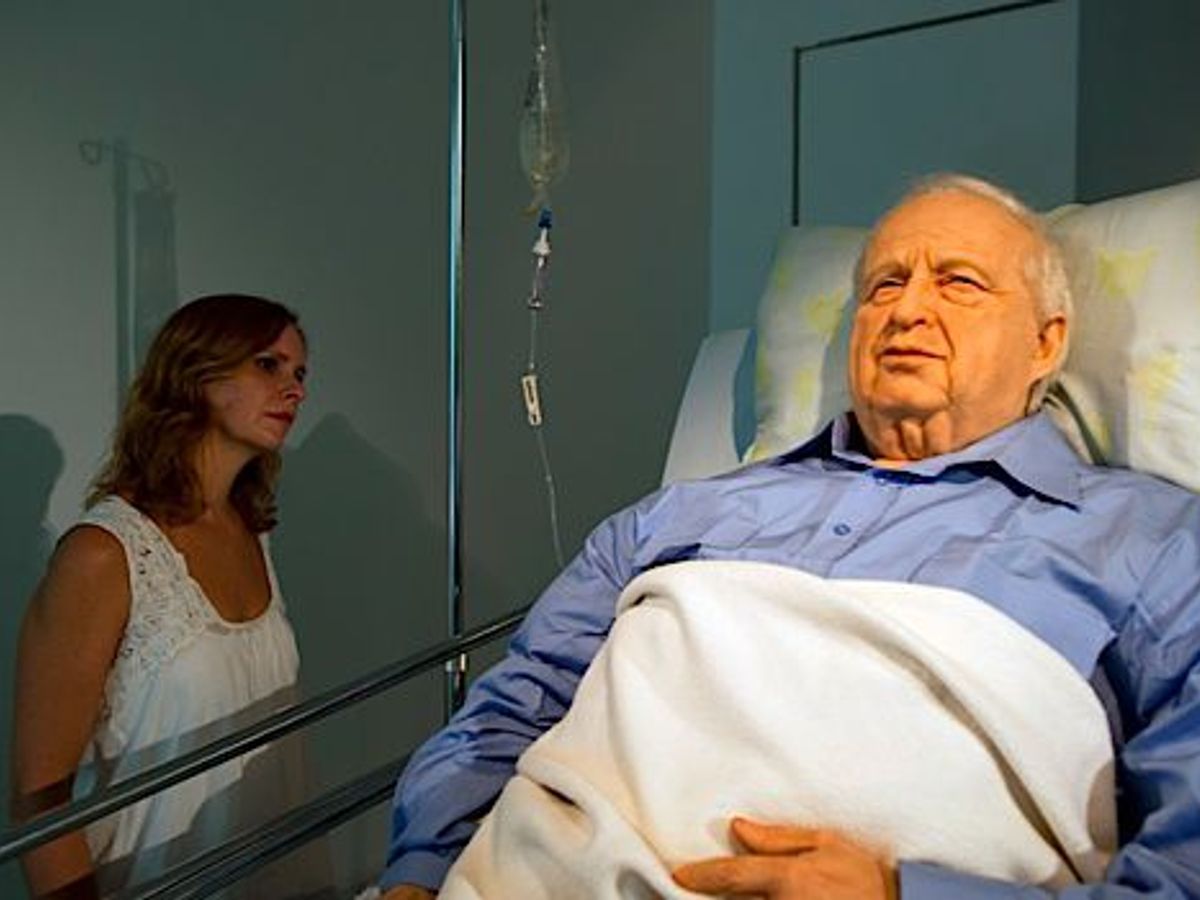The Real Legacy of Ariel Sharon
By Victor Vaughn
The Red Phoenix
OpEds
Former Israeli Prime Minister and war criminal Ariel Sharon died on Jan 11th, 2014, after having spent the last eight years in a coma. He was 85 years old. Sharon was directly involved in war crimes and massacres throughout his career and was one of the most dominant political and military figures in the history of Israel. He was buried in a state funeral is Israel with full honors, being praised as a hero and a peacemaker. He never stood trial or faced justice for his crimes.
The appalling deeds of Sharon have been ceaselessly whitewashed by the bourgeois press, portraying him as a good patriot and a seeker of peace in the region, rather than the aggressive warmonger and genocidaire he was. Sharon was nothing less than a career war criminal, a proponent of state terrorism and apartheid against the Palestinians. He was also one of the United States’ oldest and most trusted allies.
Early Military Career
In 1942, the 14-year-old Ariel Sharon joined the Gadna, an Israeli paramilitary organization for youth, and eventually joined the Haganah, an underground paramilitary force and the precursor to the Israeli Defense Forces (IDF). The Haganah was a Zionist organization that was active in the British Mandate of Palestine before the establishment of the state of Israel. It eventually resorted to terrorism and armed struggle against the British after World War II when they refused to allow unlimited Jewish immigration to Palestine. From 1947 onward it clashed with the British and Palestinians, cooperating with other Zionist paramilitaries like the Irgun and the Stern Gang. When Israel became a state in 1948, the Haganah became the core of the new IDF.
Following the Israeli declaration of independence, Sharon gained attention for his military leadership in the subsequent 1948 Arab-Israeli War. Thus, Sharon started his military career in the very heart of the foundation of the Zionist state. Sharon was directly involved in all the major wars of Israel’s history, and was an active participant in war crimes even as far back as 1947.
During the war, 400,000 Palestinians were expelled from the the territory. Sharon’s unit of the Haganah, the Alexandroni Brigade, was involved in a massacre in the Palestinian village of Tantura and atrocities against Arabs around the village of Kfar Malal. In late 1948, after recovering from injuries from the war, Sharon met major Zionist leader and first Prime Minister of Israel David Ben-Gurion, who gave him the name Sharon.
After returning to his unit, Sharon was promoted to the rank of company commander and in 1950 became an intelligence officer for the IDF. He took leave for two years to study history and Middle Eastern culture at the Hebrew University of Jerusalem, but returned to active service as a Major under the direct order of Prime Minister David Ben-Gurion. He became the leader of the newly-formed Special Forces Unit 101.
Operation Shoshana and the Qibya Massacre
The main purpose of Unit 101 was to act as a “retribution squad” to organize bloody reprisals for attacks by the Palestinian Fedayeen. In October 1953, Israeli troops from Unit 101 under the command of Ariel Sharon linked with a paratrooper brigade and set in motion “Operation Shoshana.” The elite commando force launched an attack on the West Bank village of Qibya. At least 69 Palestinian villagers, two-thirds of them women and children, were killed. Forty-five houses, a school and a mosque were destroyed.
S I D E B A R
How to Admit Without Admitting: the Lifetime War Criminal was a "Complex Man"
By Shaun Rodgers
This is how the bourgeois press handled its homage to Sharon (excerpts from the NYTimes). Buried toward the bottom of an inevitable eulogy upon his passing, Jodi Rudoren, the designated writer for the NYT's obit Israel Bids Farewell to Sharon, a ‘Complex Man’ (Jan 13, 2014), said the following:
The son of Russian immigrants, Mr. Sharon grew up on a semicollective farm, and as a teenager joined the Haganah, the pre-state Zionist fighting brigade. He created Israel’s first elite special forces unit, 101, in 1953; commanded paratroops in the 1956 Sinai campaign; and led soldiers across the Suez Canal in the 1973 Arab-Israeli war.
The son of Russian immigrants, Mr. Sharon grew up on a semicollective farm, and as a teenager joined the Haganah, the pre-state Zionist fighting brigade. He created Israel’s first elite special forces unit, 101, in 1953; commanded paratroops in the 1956 Sinai campaign; and led soldiers across the Suez Canal in the 1973 Arab-Israeli war.
“In every place that we have marched in, you have always been there before us,” said Lt. Gen. Benny Gantz, chief of Israel’s military. “Every target that we have attacked, you have known from previous battles.”
Mr. Sharon faced condemnation abroad for episodes like a 1953 reprisal attack against the West Bank village of Qibya, then under Jordanian rule, in which 69 Palestinians were killed. He was ousted as defense minister after the 1982 Lebanon War, and is still denounced as a war criminal by some human rights groups for the massacres of Palestinians in the Sabra and Shatila refugee camps in Beirut.
The U.N. Security Council passed a Resolution strongly condemning the attack. Ariel Sharon, who led the operation, later wrote in his diary: “The orders were utterly clear: Qibya was to be an example for everyone,” and that his orders were to inflict “maximal killing and damage to property.” No sanctions or pressure were put on Israel.
Sharon led the 890 Paratroopers Brigade in raids into Arab territory, soon establishing himself as a brilliant military strategist and a ruthless, insubordinate soldier. Survivors of his commando raids universally reported brutality and war crimes.
Suez War and the Khan Yunis Massacre
Israel joined hands with the United Kingdom and France to invade Egypt during the Suez Crisis. The Anglo-French-Israeli aggression against Egypt came in 1956 when Egypt nationalized the company that operated the strategically vital Suez Canal. Britain and France aimed to assert their dominance in the Middle East and seize the canal by force, and Israel’s aims were to weaken its Arab neighbors and gain territory from Egypt. The Western powers thus showed their support for Israel’s expansionist policies and Israel showed its willingness to join with imperialism.
Israeli troops began the war by invading Egyptian territory and occupying the Sinai Peninsula while Anglo-French forces began a bombardment of Egypt and occupied the Port Said area. This invasion was bravely resisted by the Egyptians, and the progressive organizations and nations of the world condemned the invasion. England and France used their veto power to paralyze the U.N. Security Council.
During the Suez War, Sharon led several decisive attacks in the Egyptian Sinai. However, it was during this period his militia terrorism made the transition to an organized military doctrine of IDF terrorism, including coordinated attacks on civilians and terror bombing.
It was during Israel’s attack on the Egyptian-held Gaza Strip that the IDF perpetrated a massacre against the Palestinian village of Khan Yunis and a refugee camp of the same name. Hundreds of Palestinians were shot in two massacres during the Israeli occupation. Although Israel tried to claim that the massacre was actually street-fighting between themselves and Egyptian-Palestinian forces and a subsequent resistance-free occupation, eyewitness accounts universally tell a story of Israeli soldiers systematically lining up and executing Arab men and suspected Fedayeen and searching homes to confiscate firearms. The mass killings also occurred after hostilities between the two belligerants had ended. The medieval caravanserai in the center of the village was used as a wall to execute Palestinian men; it remains riddled with bullets to this day.
In the nearby refugee camp, eyewitness accounts attested to the same activity: men were taken from their home by the IDF and summarily executed. 275 people were killed in the massacre, including 140 refugees from the camp. A strict curfew was imposed which prevented the gathering of the dead. Upon Israel’s withdrawal from the Gaza Strip in 1957 under international pressure, mass graves of Arab men who had been bound and shot in the back of the head were found.
In one battle, Sharon led his troops through the Sinai’s Mitla Pass against the orders of his superiors. Allegations were made in later years that Sharon had intentionally provoked and engaged Egyptian positions without authorization so that a battle would ensue. Sharon’s actions in Mitla and the resulting heavy Israeli casualties stalled his military career for several years.
Six-Day War
In 1967, an armed attack by Israel against Egypt, Syria and Jordan led to the seizure of the Sinai Peninsula and the Gaza Strip from Egypt, the West Bank and East Jerusalem from Jordan and the Golan Heights from Syria, tripling the size of the Israeli state. Israel claimed it was a “preemptive” strike against a planned invasion by Egypt, a position it later had to abandon. An estimated 300,000 Palestinians left the West Bank and Gaza. Israel declared it would not give up conquered territories. A war of attrition would be fought for several years between Egypt and Israel along the Suez Canal.
In the lead-up to the Six-Day War, Sharon rose rapidly in the ranks of the army, eventually becoming a Major General. During the war he was assigned to command the most powerful armored division on the Sinai front. Again Sharon followed his own strategy against the orders of his superiors, and enacted his own complex battle plan. This culminated in the Battle of Abu-Ageila, where Sharon’s victory against the Egyptians played a vital role in Israeli seizure of the Sinai. Sharon was promoted to the head of the IDF’s Southern Command, which he held until he was relieved of duty in 1974.
Yom Kippur War
Israel’s refusal to settle the results of the Six-Day War and give back its conquered territory led to a new outbreak of hostilities in 1973, on the Jewish holy day Yom Kippur. In what is often called the “Yom Kippur War,” Egypt and Syria, supported by Iraq, Jordan, Libya and other Arab states, attacked Israel. Egyptian forces struck across the Suez, while the Syrians advanced from the north. The war caught Israel off-guard, and the increased military capacity of the Arab states made a big impression. An oil embargo imposed by the Arab side also proved effective in proving the new balance of forces, and two U.S.-Soviet sponsored ceasefires were drawn up in 1974. Israeli territorial gains from the Six-Day War were largely given up, but the war ended inconclusively.
Sharon was recalled to active duty to fight in the war, commanding a reserve armored division. In a tactical move that yet again went against the command of his superiors, Israeli forces under his command crossed and encircled the Suez, undermining the Egyptian Second Army and encircling and capturing the Third Army. This decisive move was regarded by many as a turning point in the Sinai ground offensive.
Sharon was brought before a military tribunal for these actions, but was released on the grounds of his military effectiveness. Due to Sharon’s controversial actions and politics, he was relieved of military duty in 1974. During this conflict, Sharon was hailed as a war hero and earned the nickname “The Lion of God.” Shortly after his retirement, Sharon entered politics when he joined the right-wing Likud party.
Entering Politics
Sharon became a special aid to Prime Minister Yitzhak Rabin from 1975 to 1976, and before the 1977 elections tried to replace Menachem Begin as the head of Likud, but was rejected. Sharon resorted to forming his own party, Shlomtzion, which won two seats in the Israeli parliament, after which it immediately merged with the Likud. Sharon showed as much cunning in politics as he did in warfare. This shrewd move earned him a post as Minister of Agriculture in the Begin administration, a post that would allow him greater connection to the rural population and farmers of Israel, becoming a “strong-armed protector” of settlers and “patron saint of the settlements.”
Sharon began using his position to encourage Jewish settlement of the West Bank, Gaza Strip and Golan Heights, winning the support of the Jewish settlers and expansionist elements within the military. During his term the number of Israeli settlements in these areas doubled. Due to the support he garnered Sharon was instrumental in Likud’s win in the 1981 elections. He was rewarded with an appointment to Minister of Defense. It was during his time as Defense Minister that Sharon would transition from “slow motion genocide” of Palestinians through settlements to armed genocide through the IDF, and commit perhaps his most infamous and genocidal crimes.
The Butcher of Beirut
In 1982, Palestinian gunmen attempted to assassinate Shlomo Argov, the Israeli ambassador in London. It soon becomes known that the assailants are part of a small organization led by Abu Nidal, which formed after a split with Yasser Arafat’s Fatah faction within the Palestine Liberation Organization (PLO). Since the split the Abu Nidal Organization (ANO) had been the mortal enemy of Arafat’s PLO. Furthermore, the ANO was also based in Syria and not Lebanon. Some say the ANO attack was ordered by an agent of the Iraqi Intelligence Service to embroil Israel in a war with Lebanon and Syria, while others suspect that Abu Nidal’s group was manipulated into the attack by Mossad. Whatever the case, it soon became known that the assassination attempt was a plot by Nidal’s splinter group to provoke Israel into an open assault upon Nidal’s enemies in the PLO. The assassins included Nidal’s cousin, and their next target was to be the PLO representative in London.
Even though the attack on the ambassador was not ordered by the PLO, the incident was used as a pretext by Prime Minister Begin and Defense Minister Sharon to launch a long-planned full-scale invasion of Lebanon to destroy the headquarters of the PLO in the Lebanese capital of Beirut and install a Zionist-friendly Lebanese government. Defense Minister Ariel Sharon launched the invasion, called “Operation Peace for Galilee.”
The government of Lebanon had expressed solidarity with the Arab victims of Israeli aggression, taking part in the 1948 Arab-Israeli war. A large number of Palestinian refugees fled to Lebanon, and Palestinian resistance organizations had been operating from Lebanese territory for decades. Lebanon also expressed support of the Arab states in the 1967 war and the relevant U.N. Security Council Resolutions calling for a settlement to the crisis. The country had had a series of chronically unstable governments, some independent and some pro-imperialist in orientation, fostering uncertain relations between the government and the Palestinian refugees and resistance organizations such as the PLO. Nevertheless, because of the support it had shown to the Palestinian cause, Lebanon had been regularly subjected to Israeli acts of aggression since 1968.
As the result of internal contradictions between pro-Western, pan-Arab, right-wing nationalist and progressive forces, with the addition of the machinations of Israel and the imperialist countries, a civil war broke out in Lebanon in 1975 which caused great damage to the country. Israel occupied the south of the country in 1978 in response to PLO actions but was forced to withdraw in favor of a U.N. force sent to control militia activity. In 1981, Beirut was subjected to Israeli air strikes against PLO targets. But now, the time for a full-scale attack by Israel had come.
On June 6th, 1982, Israeli forces launched a massive invasion of the south of Lebanon at Ariel Sharon’s command. Sharon presented it to the Israeli parliament and the international community as a limited incursion 40 kilometers into Lebanon, but the IDF quickly swept throughout the country towards Beirut. Four armored columns cross into Lebanon, coupled with an amphibious assault of tanks and paratroopers north of Sidon. The cities of Tyre and Sidon in South Lebanon were heavily damaged, but even these would pale next to the Siege of Beirut.
Seven days after the start of the invasion, the IDF closed a ring around Beirut and began a savage artillery bombardment of the city, in which the PLO was isolated. For ten weeks, Israel attacked the city by land, sea and air, indiscriminately bombing the city with aircraft, cutting off food, water and electricity, capturing the Beirut Airport and southern suburbs in heavy house-to-house fighting. By the end of the first week over five hundred buildings had been destroyed and civilians had died by the thousands. By the end of the brutal siege, much of Beirut lay in ruins.
During this time, Ariel Sharon presented a plan for a large-scale conquest of West Beirut to destroy the PLO with the approval of Prime Minister Begin. The plan was rejected by the Israeli cabinet due to the amount of deaths it would cause. Some parties even threatened to leave the ruling coalition if the plan was adopted.
Israel’s invasion of Lebanon approved by Sharon, since it was a pre-planned invasion under faulty pretenses with the intention to retain occupied Lebanese territory, violated the United Nations Charter. The Security Council endorsed a draft Resolution to condemn the Israeli invasion and demand immediate withdrawal by a vote of 14 out of 15, but the draft was vetoed by the United States. Israel also attacked Syrian positions in Bekaa Valley, shooting down Syrian aircraft and destroying anti-air defense installations. Israeli armored units drove the Syrian army back. The Israeli assault on Syrian forces when the two countries were not in a state of war and Syria had made no offensive gesture towards Israel again violated international law.
On August 10th, with the U.S. pressuring Israel through its special envoy Philip Habib to come to an agreement for peace that involved the safe passage of the PLO out of Lebanon, Defense Minister Sharon raised the stakes and ordered a saturation bombing of Beirut, during which six hundred civilians were killed and thousands more were injured. In response to these actions and the fact that Sharon had lied to his own government about his motivations for the war, the cabinet stripped Sharon of his ability to command the air force, armored brigades and artillery without the consent of other branches of the government, effectively stripping Sharon of most of his powers.
A peace agreement was finally reached on August 18th, Syria having agreed to the deal since the 7th. All the demands of Israel and Sharon were met. Over a period of several weeks following August 21, Yasser Arafat and thousands of PLO fighters were forced to leave Lebanon by sea and land under the supervision of a multinational force of troops. The bulk of PLO fighters were transferred to Tunisia while others were dispersed to Syria, Yemen and Iraq, further away than ever from their ancestral homeland.
The Israeli invasion of Lebanon resulted in more than thirty thousand deaths and half a million homeless. Israel withdrew in the main by 1985 but occupied part of South Lebanon amounting to 10% of Lebanon’s territory, which the Israelis called a “Security Zone,” for nearly twenty years until 2000. Despite these atrocities, the 1982 war is primarily remembered for what would be Sharon’s most infamous crime: the Sabra and Shatila Massacre.
The Sabra and Shatila Massacre
From the very first day of the invasion of Lebanon, Ariel Sharon entered into secret negotiations with Bachir Gemayel, the Maronite Christian leader of the far-right Phalangist paramilitary organization for joint operations in Beirut between the IDF and the Phalange militia. A possible war with Syria was also considered. Gemayel had been a supporter of the Israeli intervention from the beginning, praising it as a “surgical operation.” Gemayel had the largest private army in Lebanon – 25,000 fighters at the time of the Israeli invasion. Israel agreed to help Gemayel become President of Lebanon, and Gemayel in return would pursue a policy favorable towards Israel and their occupation of southern Lebanon, and would expel the PLO headquarters from Beirut.
On August 23, after the conclusion of the tentative peace agreement, the Lebanese parliament elected Gemayel as President under Israeli guns. Israel sought to destroy the PLO command and install a far-right, Christian pro-Zionist government under Gemayel. Israel attempted to get the new President to sign a peace accord, but Gemayel was assassinated three weeks later on September 14th by a car bomb, temporarily ruining Sharon’s plans. In the wake of his death, Sharon broke the ceasefire and ordered the security forces in Lebanon to occupy West Beirut, near where the Sabra and Shatila refugee camps were located.
By noon on September 15th, the Sabra and Shatila camps were completely surrounded by the IDF forces under Sharon’s command, sealing off the camps and preventing helpless civilians from escaping what was to come. The security forces set up checkpoints and entrances, and occupied multi-story buildings with unobstructed panoramic views of Sabra and Shatila. Ariel Sharon and IDF Chief of Staff Rafael Eitan met with the Phalangist militia leaders, telling them the PLO was responsible for Gemayel’s assassination (a Lebanese Christian member of the Syrian Socialist National Party confessed and no Palestinians were involved) and inviting them to enter Sabra and the adjacent Shatila.
1,500 militiamen assembled in the Israeli-controlled airport and were transported to the area by IDF jeeps. Israel also provided the militia with careful instructions on how to enter. Beginning from 6:00 p.m. on September 16, over 3,000 Palestinian refugees were massacred by the militia under the command of Eli Hobeika over a period of three days while Sharon’s Israeli security forces stood by and watched.
There were no combatants in Sabra or Shatila; only Palestinian civilians and a small number of Lebanese Shiites. During the first night, the Israeli forces fired flares to light the militia’s way at the Phalangists’ request. According to one witness the camp was so brightly lit it was like “a sports stadium during a football game.” Israel’s allies slaughtered men and boys, women, children, infants and the elderly. Many bodies were found to have been severely mutilated: boys were castrated, others were scalped or had the Christian cross carved into their bodies. Rape was extremely prevalent. Children and infants were killed for sport. Israeli bulldozers buried the corpses of the victims in mass graves.
Blame was shifted from Sharon and Israel to the Lebanese Phalange that carried out the massacre at Sabra and Shatila, but Sharon organized the massacre by being closely allied with the militia, giving them the “green light” to attack the camps, and ordering his soldiers to do nothing, or even aid the attackers logistically while the mass murder happened. Without Sharon and the Israelis, the massacre in the Israeli-controlled camps would not have been possible.
The massacres were publicized to an international outcry. The United Nations General Assembly condemned the massacre at Sabra and Shatila and determined it to be an act of genocide. The Kahan Commission was convened by the the Israeli parliament to investigate the massacres at Sabra and Shatila. It was chaired by the President of the Supreme Court. In 1983, the commission found Defense Minister Ariel Sharon to hold “personal responsibility” for the massacre and the actions of the IDF which controlled the camps. Sharon resigned from his position as Defense Minister after initially refusing to do so, but was not prosecuted for the mass murder. Prime Minister Begin immediately appointed him as a “minister without portfolio” and Sharon was allowed to remain in the parliament and held a variety of offices in successive governments.
In 2001, relatives of victims of the massacre filed a lawsuit against the newly-elected Prime Minister Ariel Sharon to bring him to trial for war crimes. The Belgian Supreme Court dismissed the case in 2003.
Campaign for Prime Minister and Temple Mount Visit
After his resignation, Sharon remained a minister without portfolio until only 1984, when he received a portfolio and became Minister for Trade and Industry until 1990. Sharon slowly re-ascended Israel’s political ladder, becoming Minister of Housing Construction, effectively being placed in charge of Jewish settlement in the West Bank and East Jerusalem. He also became a member of the Foreign Affairs and Defense Committee, and oversaw Jewish immigration from the Soviet Union. Sharon soon became the main rival of Prime Minister Yitzhak Shamir, trying in several bids to replace him but failing each time. Sharon was Minister of National Infrastructure in the administration of Benjamin Netanyahu and then Foreign Minister from 1998 to 1999. After the electoral victory of Ehud Barak’s Labor Party, Sharon became the head of Likud in 1999.
During his campaign for Prime Minister on September 28, 2000, Sharon, guarded by a thousand Israeli security forces and police, embarked on a controversial visit to the Al Aqsa mosque in the Temple Mount complex in Jerusalem. Sharon declared that the complex would remain under Israeli control. This highly provocative action was clearly designed to assert the Israeli right to set foot in the Muslim holy place. This action by the “Butcher of Beirut” would lead to large Palestinian protests by September 29th, the Muslim Day of Prayer. Prime Minister Barak dispatched an enormous police and military presence to the mosque. By the following day the protests had grown larger, and Israeli police used live ammunition to suppress the demonstrators, killing five and injuring over 200, including 12-year-old Muhammad al-Durra. These events would lead to both Sharon’s election as Israeli Prime Minister and the Second Intifada Palestinian uprising against Israeli occupation, also known as the Al-Aqsa Intifada, which would be marked by severe IDF repression of Palestinians.
Sharon as Prime Minister
In May 2001, Ariel Sharon replaced Ehud Barak as the Israeli Prime Minister. Sharon’s election was hailed by the United States, who called him one of “America’s oldest and strongest allies.” No mention was made of his war criminal past. During the Second Intifada he oversaw increasingly savage Israeli repression against Palestinians, in turn causing an escalation of Palestinian reprisals as well as suicide bombings by organizations such as Hamas and the PLO split called the al-Aqsa Martyrs Brigade. Months later, Sharon ordered a full-scale IDF invasion of the West Bank and the Gaza Strip, razing entire communities to the ground. The repression was so severe that even U.S. President George W. Bush called for an Israeli withdrawal, which Sharon ignored. This was to be the first of a series of IDF incursions into what remained of Palestine, all of which were marked with war crimes.
Sharon endorsed Jewish settlements in the Gaza Strip and West Bank while at the same time authoring a unilateral disengagement plan, putting the idea of an independent Palestinian state, in the words of Sharon’s own spokesman Dov Weissglass, into “formaldehyde.” This startling revelation by Sharon’s right-hand man openly admitted that the goal of the disengagement plan was to “freeze the peace process” and prevent the creation of a Palestinian state, as well as “prevent a discussion on the refugees, the borders and Jerusalem.”
Colonization and the “Unilateral Disengagement Plan”
Many politicians, particularly from the United States, have portrayed Sharon as a “peacemaker” who gave concessions on Jewish settlements in Palestinian territory to pursue peace with the Palestinians. President Barack Obama issued a statement on Sharon’s death where he stressed the United States’ “unshakable commitment to Israel’s security” and at the same time said the U.S. would “strive for lasting peace.”
U.S. Secretary of State John Kerry said Sharon “surprised many in his pursuit of peace,” and even praised Sharon’s “lifelong convictions” for a peace process. United Nations Secretary-General Ban Ki-Moon praised Sharon’s “political courage and determination” in his “painful and historic decision to withdraw Israeli settlers and troops from the Gaza Strip.” Tony Blair claimed Sharon “didn’t think of peace as a dreamer, but did dream of peace” and “sought peace with…iron determination.”
These shibboleths cannot disguise the truth. Since the 1970s, Sharon was one of the chief architects of the Israeli settlement of the West Bank, East Jerusalem and the Golan Heights region. He was given the moniker “father of the settlements.”
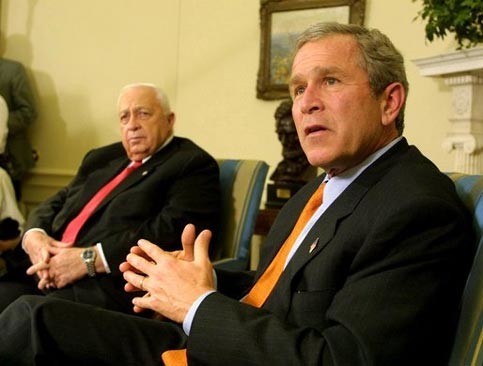 In 2003, U.S. President George W. Bush put forward a plan known as the “roadmap for peace in the Middle East,” which offered a land-for-peace deal in which Israel would be called upon to partially abide by previous United Nations Security Council Resolutions, and a Palestinian state would be established by 2005. The Palestinian National Council immediately agreed to the proposal, while the Sharon government initially refused the proposition. Eventually, under heavy pressure from the United States, Sharon’s Israel reversed their position under the condition that Yasser Arafat stepped down and the PNC halted all military actions. No mention was made of Israeli military actions.
In 2003, U.S. President George W. Bush put forward a plan known as the “roadmap for peace in the Middle East,” which offered a land-for-peace deal in which Israel would be called upon to partially abide by previous United Nations Security Council Resolutions, and a Palestinian state would be established by 2005. The Palestinian National Council immediately agreed to the proposal, while the Sharon government initially refused the proposition. Eventually, under heavy pressure from the United States, Sharon’s Israel reversed their position under the condition that Yasser Arafat stepped down and the PNC halted all military actions. No mention was made of Israeli military actions.
Arafat agreed to the proposal and stepped down in favor of Mahmoud Abbas. Sharon continued to order IDF actions against Hamas and other Palestinian organizations under the excuse of continued Hamas and Islamic Jihad actions. Finally, the two organizations agreed to suspend their actions, leaving Sharon no choice but to withdraw his troops from the West Bank. It should be further noted that these political moves took place in the context of the number of Jewish settlers in the West Bank increasing from 388,000 to 461,000. Sharon’s alleged “concessions” for peace were a slight and short-lived rollback. He resorted to troop withdrawal and peace talks as a matter of having no alternative.
Thus, Sharon once again showed himself to be a pioneer in new ways to steal land from Palestinians: he engineered a withdrawal from the Gaza Strip and West Bank while at the same time keeping control of them from without. All of Sharon’s “concessions” have also not prevented Israel from laying bloody sieges to the West Bank and Gaza Strip on a regular basis, nor have any of them involved an Israeli withdrawal from the occupied Golan Heights (which even the United States recognizes as Syrian territory), and have not prevented Israeli control of Palestinian coastline and airspace. Sharon also ordered the construction of apartheid walls, including a 430-mile-long barrier around the West Bank, a fence caging in the entire Gaza Strip, and a steel barrier separating Gaza from Egypt.
The End of Sharon’s Career
In November 2005, facing a split over the issue of the “disengagement” plan, Sharon resigned as head of government, stepped down from the leadership of the Likud party, dissolved parliament and called for new elections. He founded the new Kadima party, made mostly of politicians from Likud and Labor who had defected. Sharon’s rival Benjamin Netanyahu was chosen as the new leader of Likud, but polls showed that Kadima were likely to win the 2006 legislative elections and Sharon to win the prime ministership. On December 18, Sharon was hospitalized for a minor stroke. Against doctor’s orders, Sharon returned to work immediately and suffered a major stroke on January 4, 2006. He underwent a complicated major surgery lasting more than seven hours. Doctors stopped the bleeding in his brain, but Sharon slipped into a coma from which he would never awaken.
The following month, the cabinet declared Sharon permanently incapacitated. Sharon was replaced by Ehud Olmert, who would later be responsible for genocidal massacres in the Gaza Strip in 2008-2009 and a second invasion of Lebanon in 2006, as Interim Prime Minister. Kadima under Ehud Olmert would win the most seats in the parliamentary elections, followed by Labor, resulting in a major loss of seats for Likud. Olmert formed a new government with himself as Prime Minister in May. Sharon would remain in a permanent vegetative state in a long-term care facility until his death.
Conclusion
The death of war criminal Ariel Sharon is a grim reminder of the crimes of the apartheid state of Israel against the Palestinian people, and the involvement of the United States and world imperialism in those crimes. Sharon’s virulently anti-Palestinian policies, aggressive wars and political tyranny, as well as his avoidance of any trial or prosecution are undeniable, as is the political, financial and military support he received from the U.S.
Israeli rule over Palestinians is fascist in nature. The Zionist state and the imperialist system that support it are bigger than one man, but Sharon was a symbol of the harsh Israeli discrimination against Palestinians, and the refusal of both the United States and Israel to accept Palestinian resistance as a legitimate and inevitable response to the forcible establishment of the Zionist state, the settlement of Jews on Palestinian land and the continued killing and expulsion of hundreds of thousands of Palestinians. Sharon was one of the first politicians to use the word “terrorism” to delegitimize this resistance.
Ariel Sharon had one goal in his life: to ethnically cleanse the Jewish “ancestral homeland” of Palestinians and carve out a Greater Israel, as large and as powerful as possible. Ariel Sharon was a genocidal monster who wanted to erase the Palestinian people from the map, not a “hero” or a “peacemaker.” Reflecting on his death, we should also reflect on the destruction Sharon brought to the lives of thousands.
Real peace for Palestine can only be achieved if Israeli forces are driven from all occupied territories, if equal rights for Arabs are upheld, if the revolutionary forces liberate Palestine from apartheid rule, and if the right of Palestinians for self-determination and the creation of their own state is realized. [That will require profound changes in Israel itself.—Ed]
The views expressed herein are solely those of the author and may or may not reflect those of The Greanville Post. However, we do think they are important enough to be transmitted to a wider audience.
If you find the above useful, pass it on! Become an "influence multiplier"!
The battle against the Big Lie killing the world will not be won by you just reading this article. It will be won when you pass it on to at least 2 other people, requesting they do the same.
| Did you sign up yet for our FREE bulletin? It's super easy! Sign up to receive our FREE bulletin. Get TGP selections in your mailbox. No obligation of any kind. All addresses secure and never sold or commercialised. |
![]() This work is licensed under a Creative Commons Attribution-NonCommercial 4.0 International License
This work is licensed under a Creative Commons Attribution-NonCommercial 4.0 International License
